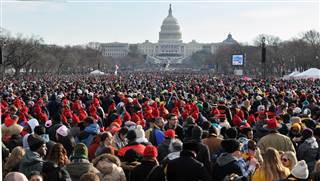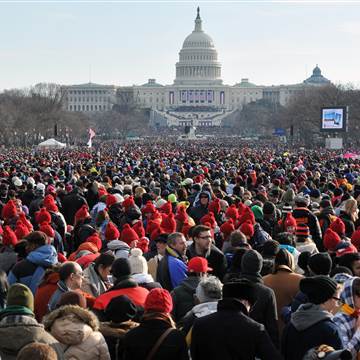No matter the turnout on Friday, it’s a safe bet that Donald Trump will point out the “yuge” and “tremendous” size of the inauguration crowd.
But estimating just how many bodies there are in a sea of people is a delicate balance of rules of thumb, some basic math, and if we’re lucky, getting an aerial view of the crowds.


Steve Doig, a professor of journalism at Arizona State University’s Walter Cronkite School of Journalism and Mass Communication, who has experience providing independent crowd estimates, said there’s a reason why we’ll likely hear some wildly varied crowd estimates on Friday.
“It’s going to be treated as fake news between the two warring camps,” he said, noting that Trump may think the estimates are too low, while “Never Trump” protesters might say it’s too high.
Related: Will Trump andTech Be the ‘Disaster’ Some People Have Predicted?
Crowd counting is never going to be 100 percent accurate, unless people are physically being counted going through a turnstile. However, there are some generally accepted rules of thumb, credited to Herbert Jacobs, who was a journalism professor at the University of California, Berkeley in the 1960s.
“It’s basically a matter of knowing the area in square feet or meters,” Doig told NBC News. “And then coming up with a reasonable density factor, which would be the average number of square feet each person is taking up. That factor is based on how closely together people are.”
One way to check on square footage is to try Google Earth.
How Crowded Is that Crowd?
There are a few general rules of thumb when it comes to determining a crowd’s density.
A “loose crowd” is one where everyone is about an arm’s length from each other. In this case, the crowd estimate would account for 10 square feet per person.
That may sound like a lot, but it’s only slight more than 3-feet by 3-feet per person. A crowd where people are grouped “shoulder to shoulder,” would account for around 4.5 square feet per person.
If people are like sardines in a mosh pit, that’s a density of about 2.5 square feet per person.
Of course, it’s sometimes hard to grasp the true density of a crowd unless there’s an overhead view. Some companies use drones to get a look at the crowd before providing a professional estimate.
However, inauguration attendees are being warned to leave their unmanned aerial vehicles at home, meaning a drone’s eye view of the event is out of the question.
“The airspace around Washington, D.C., is among the most restricted in the country,” the Secret Service said in a statement earlier this month. “Rules put in place after the 9/11 attacks establish ‘national defense airspace’ over the area and limit aircraft operations to those with an FAA and Transportation Security Administration authorization.”
A high-resolution satellite passed over the Obama inauguration in 2009, giving crowd counters a better grasp of the density, and helped inform their estimates.
“To do the inauguration right, you need an overhead view — but that is unfortunately hard to get in DC because there are no tall buildings [from which shots could be taken], and no planes or helicopters can fly over it,” Doig said. “With that, it makes it very difficult, unless the odd satellite happens to be passing over.”
Allison Puccioni, principal and founder of Armillary Services, who has nearly 25 years in imagery analysis, said that high-resolution satellites provide the best estimate for crowd numbers, whether it’s a rock concert or counting refugees. There’s just one caveat — there had better not be cloud cover in the way.
When it came time to estimate the crowds at the 2009 inauguration, Puccioni told NBC News she was working with a 90-minute deadline from a major news organization.
“It was very arduous. I did two takes in 90 minutes,” she said, explaining how she calculated square footage, density factors and then got to work doing the math in a spreadsheet.
While she wouldn’t recommend the tight deadline, she said her numbers still added up when she redid them.
“I went back after the estimate and spent a week recalibrating and got pretty close to the same number,” she told NBC News.
So no matter how the math shakes out on Friday — and for the marches planned around the United States on Saturday — look for estimates from people who are versed in the methods of independent crowd counting. It may not be on the nose, but it will surely give you a better idea than just being told the crowds were “yuge.”






